#Synapsid
Text



I used a piece of one of my favourite background fabrics to make the sail for this tiny dimetrodon!
#dimetrodon#synapsid#sewn by me#artist plush#plushie#toys#prehistoric#rainbow#blue#bright colour#toy with accessories
5K notes
·
View notes
Text
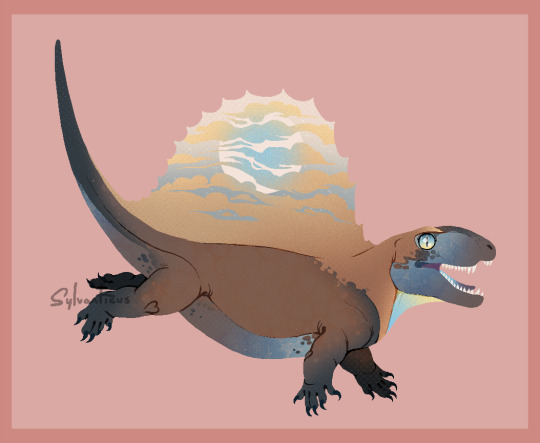
a Dimetrodon!!!
#khyrosart#art#artists on tumblr#dinosaur#paleoart#paleo art#paleontology#paleoblr#dinosaurs#dino#dimetrodon#Synapsid#extinct animals#prehistoric#pixels#pixelart#pixel art#I know it's not a dino but yeah
910 notes
·
View notes
Text

#halloween blogging#memes#paleoblr#cotylorhynchus#dimetrodon#inostrancevia#permian#synapsid#therapsid
2K notes
·
View notes
Text
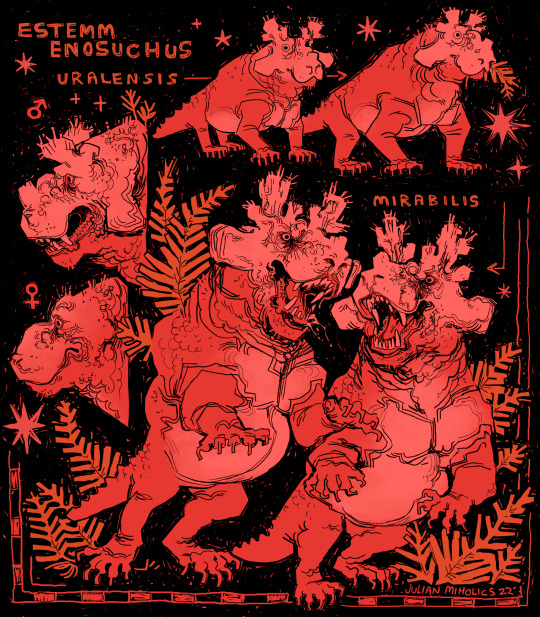
once again drawing our ancient cousins, this time estemmenosuchus of the permian era
3K notes
·
View notes
Text
Something just occurred to me:

They’re Therapsids!



(Paleoart by Gabriel Ugueto and Roman Yevseyev)
#ghostbusters#zuul#therapsid#synapsid#permian#estemmenosuchus#anteosaurus#paleontology#dinocephalian#peregrine op
231 notes
·
View notes
Text
It's commonly said that synapsids were reptiles, but that's not true. They were synapsids.
See, there's a fork in land animals (tetrapods): amphibians on the one side, amniotes on the other.* Amniotes then fork again: reptiles on one side, synapsids on the other.
Birds are a kind of reptile. And we mammals are a kind of synapsid!
Take a look in the mirror and admire yourself. You're looking at one of the last synapsids alive.
*(simplified, not counting all the extinct clades)
3K notes
·
View notes
Text
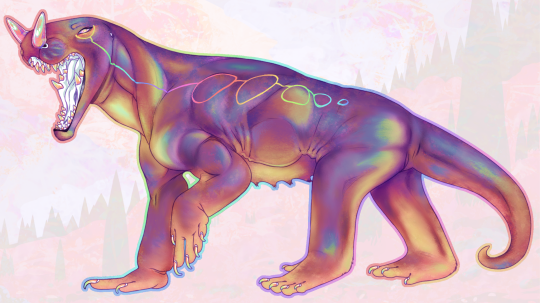
a long time ago youd have called her "mom" !
#gorgonopsid#paleoart#inostrancevia#pelycosaur#gorgonops#synapsid#stem mammal#mammal like reptile#adoptable#character design#rainbow
459 notes
·
View notes
Text
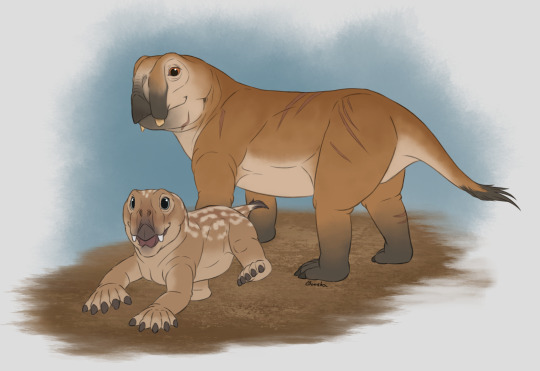
A Lystrosaurus and her calf. She's been in a lot of fights to protect her kids.
They're not known to have fur, but I put little tail tuffs anyway, since mammals with similar skin (like elephants) have them.
151 notes
·
View notes
Text
Crystal Palace Field Trip Part 1: Walking With Victorian Monsters

The Crystal Palace Dinosaurs take their name from the original Crystal Palace, a glass-paned exhibition building originally constructed for a World's Fair in Hyde Park in 1851.
In 1854 the structure was relocated 14km (~9 miles) south to the newly-created Crystal Palace Park, and a collection of over 30 life-sized statues of prehistoric animals were commissioned to accompany the reopening – creating a sort of Victorian dinosaur theme park – sculpted by Benjamin Waterhouse Hawkins with consultation from paleontologist Sir Richard Owen.
The Palace building itself burned down completely in 1936, and today only the ruins of its terraces remain in the northeast of the park grounds.

The Crystal Palace building then and now
Left image circa 1854 (public domain)
Right image circa 2011 by Mark Ahsmann (CC BY-SA 3.0)
Six sphinx statues based on the Great Sphinx of Tanis also survive up among the Palace ruins, flanking some of the terrace staircases. They fell into serious disrepair during the latter half of the 20th century, but in 2017 they all finally got some much-needed preservation work, repairing them and restoring their original Victorian red paint jobs.

———
…But let's get to what we're really here for. Dinosaurs! (…And assorted other prehistoric beasties!)
The "Dinosaur Court" down in the south end of the park still remains to this day, displayed across several islands in a man-made lake. Over the decades they've been through multiple cycles of neglect and renovation, and are currently cared for by the London Borough of Bromley (Crystal Palace Park Trust are due to take over custodial duties in September 2023), with promotion and fundraising assistance from organizations like Historic England and the Friends of the Crystal Palace Dinosaurs charity.
Just about 170 years old now, the Crystal Palace Dinosaurs represent fifteen different types of fossil creatures known to 1850s Victorian science, with only three actual dinosaur species featured. Although often derided for being outdated and very inaccurate by modern standards, they were actually incredibly good efforts at the time, especially taking into account that the field of paleontology was still in its very early days.
They also just have a lot of charm, with toothy grins and surprisingly dynamic poses.
Unfortunately on the day I visited in early August 2023 most of the statues were heavily obscured by plant growth, both on their islands and on the sides of the paths they can usually be viewed from. Since I'd seen images from about a month ago showing things being less overgrown, this was probably just some unlucky timing on my part coinciding with some explosive summer foliage growth.
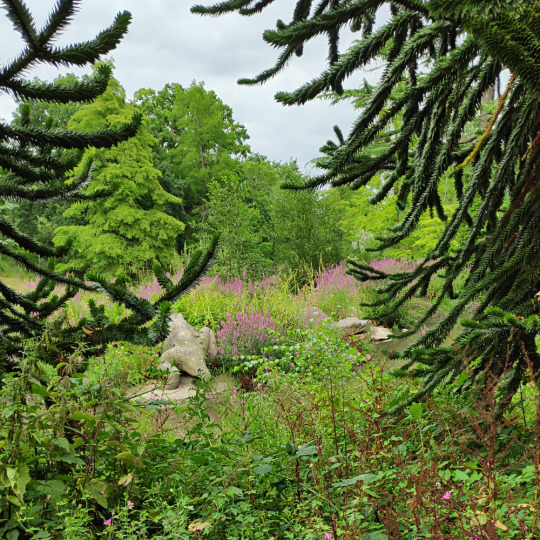
The first island on the trail features a few Permian and Triassic animals which were only known from fragmentary remains in the 1850s. These "labyrinthodonts" were recognized as having similarities to both amphibians and reptiles, and so were depicted with boxy toothy jaws, warty skin, stumpy tails, and long frog-like back legs.

Today we'd call these particular animals temnospondyl amphibians, specifically Mastodonsaurus, and we know they were actually shaped more like giant salamanders with longer flatter crocodilian-like jaws, smaller legs, and long paddle-like tails.

———

Somewhere in the foliage beyond this specific "labyrinthodont" there was also supposed to be a pair of dicynodonts, but I couldn't see much of them at all and didn't manage to get a remotely visible photograph.

Crystal Palace Dicynodon when much less overgrown
Left photo by London looks (CC BY 2.0)
Right photo by Loz Pycock (CC BY SA 2.0)
These Dicynodon are depicted as looking like sabre-toothed turtles complete with shells. That was fairly speculative even for the time, but considering only their weird turtle-beaked-and-walrus-tusked skulls were known it was probably the best guess Hawkins and Owen had. Today we know these animals were actually synapsids related to modern mammals, but Victorian understanding considered them to be a type of reptile.
Modern reconstructions of dicynodonts have a slightly different face shape, along with squat pig-like bodies and semi-sprawling limbs. They may have had fur, but currently the only known actual skin impressions from the genus Lystrosaurus show leathery bumpy hairless skin.

———
Next time: the Jurassic and Cretaceous sculptures!
#field trip!#crystal palace dinosaurs#retrosaurs#i love them your honor#crystal palace park#crystal palace#labyrinthodont#temnospondyl#mastodonsaurus#dicynodont#dicynodon#synapsid#paleontology#vintage paleoart#art
374 notes
·
View notes
Text

Inostrancevia enjoys a plate of Spaghetti
(Though the PoT mod with their bloody mouths was funny)
149 notes
·
View notes
Text




Seastar (he/him)
A gorgonops beanie sewn by me in October 2023. A revised version of my first printed plush design, the mini gorgonops, made bigger and beanier.
#gorgonops#gorgonopsid#synapsid#prehistoric#sewn by me#plushie#toys#blue#toy with accessories#printed fabric
747 notes
·
View notes
Text
The Moonbearer

88 notes
·
View notes
Text

Another sketch brought to you by #paleostream
Anteosaurus, bane of the Permian. A titanic synapsid, build like a cress between bear and komodo dragon but the size of a rhino.
487 notes
·
View notes
Photo
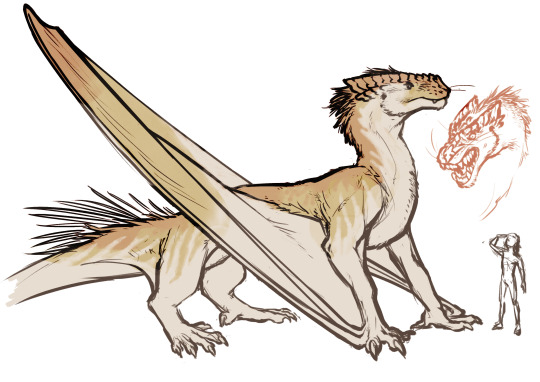

Speculative evolution side of tumblr I’m in need of your constructive criticism!
I tried to speculate some dragons based on synapsids instead of more “regular” reptiles. But do they make any sense???? Pls halp!
They’re loosly based on gorgonopsyds but I gave them wings in convergent evolution with the pterosaurs. I guess they shouldn’t be able to fly without air sacs in their body and hollow bones so I’m also guessing they conveniently evolved those as well.
I’m not entirely sure about the horns in general, because I don’t know wether or not they would make sense (I thought maybe could be an adaptation to protect the nose from cold winds and grew to be a communication display? Idk idk anything!). Should they actually be more scaly? More horned? I already know I’ll try with manes, cuz they might look nice in them!
Another thing that looks weird to me are the Feets. I can’t place myself where they look wrong. Please feel free to give me a heads up! I tried with a semi-plantigrade stance and took inspo from thylacines but clearly it ain’t it. (is it even a thing actually?)
For the marine dragon I went with sturdier constitution and small wings, for water propelling (should they be even smaller???) and big, hollow horns for (possible?) echolocation. Strong limbs to climb cliffsides and find nice safe spots to nest and from where to dive for food. (on this note... would these dragons lay eggs or... what???)
Let me know what you think about it, I’ll be more than happy to discuss these very incomplete stages of speculation!
#dragons#summoning fellow biology nerds very hard#feel free to interact#speculative zoology#speculative evolution#synapsid#help me!#discussion#speculative evolution discourse#these will very likely be the dragons in my next dnd oneshot#d&d#Dungeons and Dragons#paleoart
638 notes
·
View notes
Text

824 notes
·
View notes
Text

A fossilized tooth of an indeterminate basilosaurid, possibly Basilosaurus isis from the Samlat Formation in Dakhla, Morocco. It is unclear if the larger teeth from these ancient whales can be attributed to Basilosaurus.
#synapsid#mammal#fossils#paleontology#palaeontology#paleo#palaeo#basilosaurus#dorudon#cetacean#whale#eocene#cenozoic#prehistoric#science#paleoblr#fossil friday#fossilfriday#バシロサウルス#ドルドン#化石#古生物学
104 notes
·
View notes